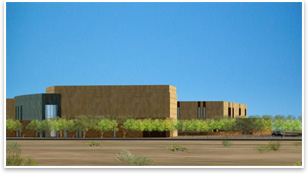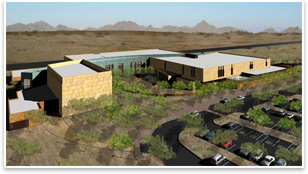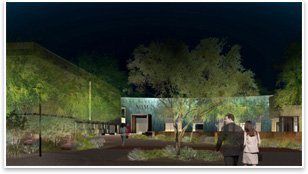
| When You Walk by, this Museum Springs (and Sings) to Life The Musical Instrument Museum goes a step beyond the player piano
How do you . . . design a museum to exhibit musical instruments in a way that communicates their cultural vitality?
As the head of what is expected to be the world’s first comprehensively global musical instrument museum, DeWalt has been challenged to implement an alternative way of displaying the tools of music that brings them to life and explains their significance as cultural artifacts. DeWalt (and the museum’s architect, Richard Varda, FAIA) say that until recently the technology did not exist to allow musical instruments to shine as dynamic signifiers of culture in museum exhibits. At their museum, visitors will be given wireless headsets that will play audio and video samples of the instruments on display, all triggered only by museum-goers proximity to the exhibit. “You’re not just looking at the instruments and admiring them as art objects, although some people will come and do that, but you’re also seeing the instruments played within their cultural context,” says DeWalt. Out of the Big Box Ulrich also chose the museum’s location. The museum was attracted to Phoenix because of its diverse and rapidly expanding population, as well as its prized status as a popular tourist destination. The museum, which broke ground in early February, will sit on a 20-acre site on the north side of the sprawling, Sunbelt city as part of a 5,000-acre master planning site called Desert Ridge. The two-story, 180,000-square-foot museum is scheduled to be completed by 2010, when museum organizers hope it will have 5,000 instruments to display.
The museum is oriented to the west, with an open, landscaped courtyard and a parking lot at the ground elevation. The courtyard brings visitors into the museum’s primary circulation device: the slate-covered central circulation spine that Varda nicknamed the museum’s “river.” This two-story, gently curving volume runs north and south through the middle of the museum and connects to the museum gift shop, auditorium, lobby, meeting spaces, and galleries. On the north end of the circulation spine is the museum’s 300-seat music theater. On the south end are administrative and support spaces, as well as galleries. The east side of the circulation spine contains two floors of galleries and more administrative and support spaces. All this forms the footprint of the building in an open-ended C-shape.
Stone is also used as a consistent element inside. Granite stone tiles will make up the flooring in the public areas, and the music theater will have walls that are partially stone. The visitors walking over these stone tiles will select which audio and video instrument exhibits they examine simply by walking near them. The wirelessly transmitted audio signals will be synchronized with video installations of the instruments on display being played. The galleries are organized by geography, with sections showcasing instruments from North America, Latin America, Southeast Asia, the Middle East, Africa, and more. The museum’s collection will have a 100-year-old Javanese gamelan, an Indonesian ready-made ensemble instrument that features xylophones, drums, and gongs. It will also exhibit six-foot-long slit gong drums from the Congo, decorated as stylized depictions of animals. The museum will have hundreds of these displays, and DeWalt says that every country in the world will be represented.
Preliminary loan agreements have already put about 1,000 pieces in the Musical Instrument Museum’s possession, some from museum giants like the Smithsonian and the Metropolitan Museum of Art in New York. Such museums, which often don’t have the room to display these objects or the inclination to make room, are anxious to get these musical instruments out of storage and in front of the public. Varda thinks it’s about time. “Musical instruments have been kind of ignored by the museum world,” he says. And that’s a shame. As DeWalt says: “It’s easy to make the argument that the art form that affects more people on an everyday basis is music.” |
||
Copyright 2008 The American Institute of Architects. All rights reserved. Home Page |
||
news headlines
practice
business
design
recent related
› Calatrava’s Tenerife Auditorium Plays a Musical Feast for the Ears and Eyes
› Biodesign Institute Beckons Best and Brightest
› UC San Diego’s New Music Center Design Combines Acoustic Performance with Striking Visuals
Visit the Museum of Musical Instrument’s Web site.






